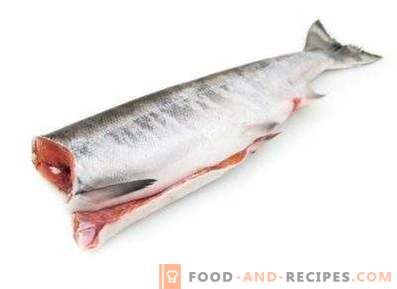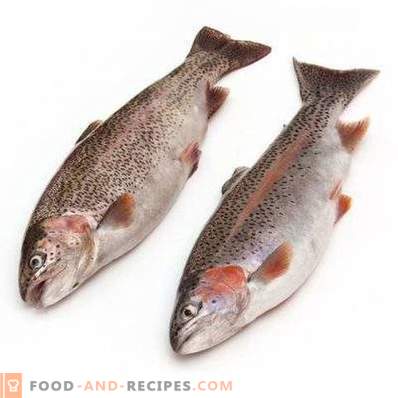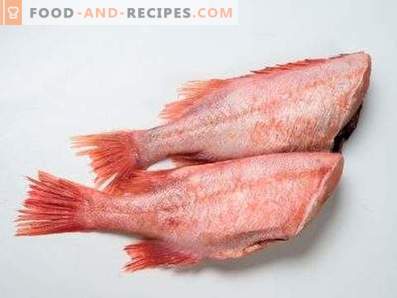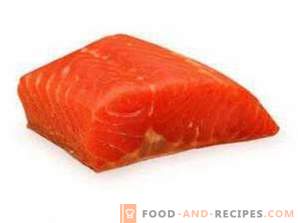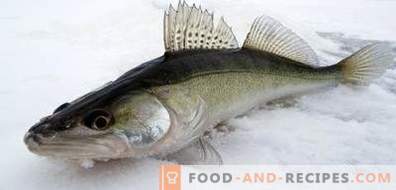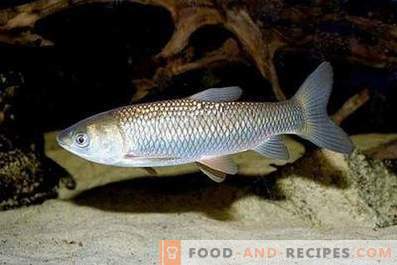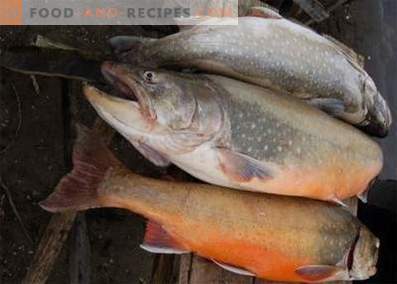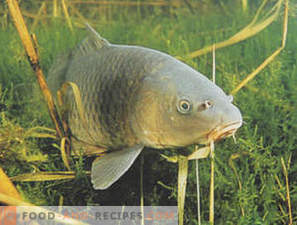
Tuna fish is a generic name for 15 species of marine fish that form the Thunnini knee in the mackerel family. Representatives of this taxonomic rank inhabit the subtropical and tropical waters of the Indian, Pacific and Atlantic oceans. Tuna fish are a valuable target. In most countries of the world their meat is considered a delicacy. It is eaten raw, canned, fried, smoked, baked and salted. In addition, tuna fillets are used to make sushi, sashimi and toppings for baking.
Appearance of fish
The tuna has an elongated spindle-shaped body, sharply tapering to the caudal stalk, a large conical head, small round eyes with a golden iris and a large mouth with one row of sharp teeth on each jaw. The belly and sides of the fish are silvery, the upper part of the body is dark blue or black. The whole body of the representatives of the tribe is covered with large scales.
There are 2 fins on the tuna's back. The first one is elongated, concave, and the second is short, crescent. The abdominal, anal and pectoral fins of the fish are small, pointed. The tail of the tuna is crescent-shaped. On the dorsal and ventral side of the caudal stem are located from 8 to 12 processes, resembling short spines in appearance. The color of the fins of fish varies from pale blue or light yellow to black.
The size and weight of tunas directly depend on the species. So, makreletuntsy have a weight of not more than 1, 8 kg. The length of the body in representatives of this species rarely exceeds 50 cm. At the same time, the largest bluefin tuna that was caught by fishermen in the waters of the Atlantic Ocean, weighed more than 680 kg. The length of his body was 460 cm.
Nutritional Value
100 g of fresh tuna contains:
- 24, 382 g of proteins;
- 4, 557 g of fat;
- 69, 114 g of water;
- 1, 644 g of ash;
- 38, 606 mg of cholesterol;
- 0, 416 g of omega-3 fatty acids.
The meat of this fish is rich in essential and non-essential amino acids, monounsaturated and saturated fats.
Vitamins in the composition of the product
Tuna fillet - a real storehouse of vitamins. This product contains:
- Niacin equivalent, PP, - 15, 604 mg;
- choline, B4, - 65, 018 mg;
- pyridoxine, B6, - 0, 767 mg;
- retinol equivalent, A, - 19, 968 mcg;
- folic acid, B9, - 5, 558 μg;
- riboflavin, B2, - 0, 241 mg;
- cobalamin, B12, - 9, 427 µg;
- tocopherol equivalent, E, - 0, 196 mg;
- pantothenic acid, B5, - 1, 049 mg;
- thiamine, B1, - 0, 277 mg.
In addition, tuna contains calciferol (vitamin D3). The concentration of this nutrient in the fish fillet is 5, 669 mcg per 100 g
Useful items
Macroelements in 100 g of tuna:
- phosphorus - 281, 064 mg;
- potassium - 348, 066 mg;
- sodium - 74, 644 mg;
- calcium - 30, 004 mg;
- sulfur - 189, 802 mg;
- magnesium - 29, 088 mg;
- chlorine - 158, 731 mg.
Trace elements in 100 g of raw fish:
- manganese - 0, 128 mg;
- nickel - 5, 899 mkg;
- iron - 0, 993 mg;
- zinc - 0, 688 mg;
- fluorine - 99, 003 mkg;
- copper - 100, 064 mkg;
- iodine - 51, 034 mkg;
- selenium - 36, 478 mcg;
- cobalt - 39, 755 mkg;
- chromium - 91, 154 mcg;
- molybdenum - 3, 969 mcg.
Tuna calories
100 g of raw tuna contains 138, 794 kcal. The energy value of the same portion of smoked fish - 142, 614 kcal, fried - 234, 711 kcal, salted - 141, 012, baked - 140, 609 kcal. Calorie canned tuna - 98, 163 kcal per 100 g
Product Benefit
- Tuna is a rich source of easily digestible animal protein. This product is useful for professional athletes, people recovering from complex surgical interventions or prolonged illnesses engaged in hard physical or mental labor.
- It has been proven that regular consumption of food from this fish helps to reduce the concentration of triglycerides in the blood.
- Nutrients contained in tuna meat increase the rate of metabolic processes in the body.
- Useful substances entering the digestive tract with this product help to normalize blood sugar levels.
- Tuna is rich in compounds that promote the excretion of excess low-density lipoproteins, toxins and poisons.
- Dishes from this fish help reduce pain in arthritis and arthritis.
- Antioxidants contained in tuna meat slow down the processes associated with aging tissues. In addition, they reduce the risk of tumor growth.
- The composition of tuna includes a whole range of nutrients that increase the immune forces of the body.
- It has been proven that regular consumption of this fish helps to increase brain activity and improve memory.
- Fillets are rich in compounds that improve digestion and prevent the development of putrefactive processes in the gastrointestinal tract.
- Tuna contains substances that positively affect the work of the central nervous system. People who include his meat in the diet at least once a week, tolerate stress and psycho-emotional upheavals more easily, suffer from depression less often, sleep better.
- Fresh fish fillet helps normalize blood pressure in hypertension.
- Phosphorus, calcium and other useful macronutrients that make up tuna strengthen bone tissue, preventing the development of osteoporosis and other diseases of the musculoskeletal system.
- Dishes from the meat of this fish have a positive effect on the reproductive system in men and women. Substances that enter the body when they are used, increase the potency, improve the composition of sperm, prevent the development of inflammatory processes, help get rid of infertility.
- Tuna is rich in substances that improve the condition of the skin and prevent their aging. Regular use of this product helps to accelerate the growth of hair and nails, reduce the risk of alopecia.
Contraindications and harm of tuna
- The absolute contraindication to eating tuna is an allergy to fish and seafood.
- Abuse of fried fillets can cause obesity.
- In the meat of marine fish with a high life expectancy, mercury often accumulates. Large tunas are no exception to this rule. That is why pregnant women and children under the age of 3 years are not recommended to use meals cooked on the basis of their fillets, more often than once a month.
- If tuna storage is violated (for example, when it is frozen again after thawing), histamine may accumulate in the fish fillet. Therefore, you can buy this product only from reliable suppliers that have proven themselves in the market.
- Tuna is contraindicated in people who have previously been diagnosed with renal failure.
- Persons suffering from cardiovascular diseases should minimize the consumption of salted, canned and smoked fish.
